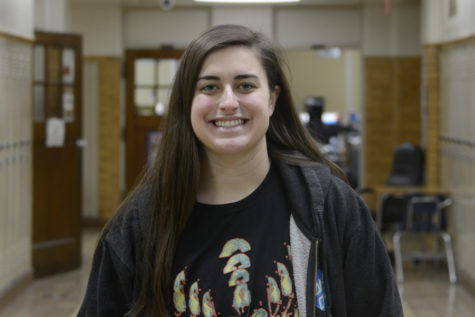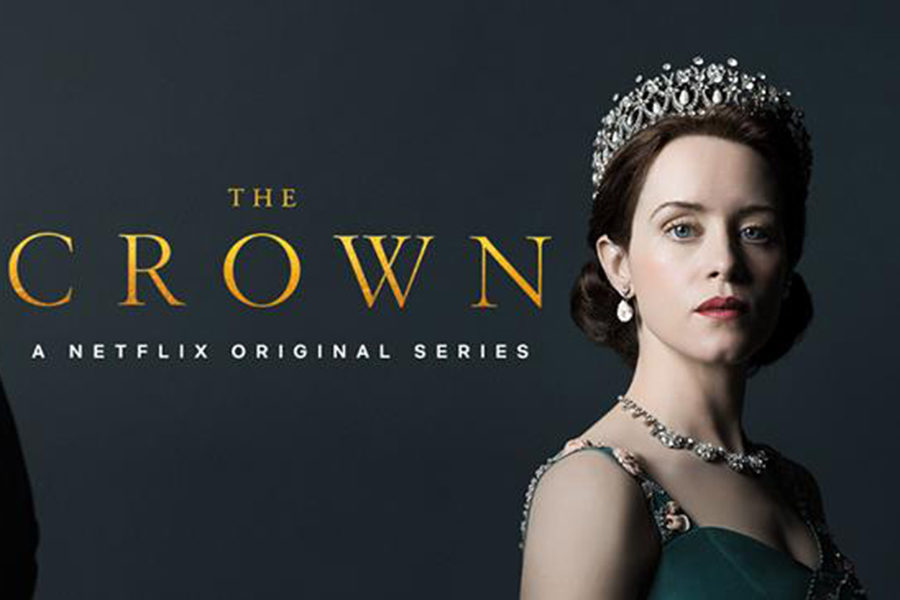The Crown Delivers on Second Season
Differing from the season on poster that featured only Foy, Claire Foy and Matt Smith as Elizabeth II and Prince Philip respectively are depicted in their full regalia on the season two poster. Foy gives the camera a head on, steely gaze reflecting her character’s new found strength and confidence in the role of Queen after having to assimilate to the role unexpectedly after the death of her father in season one. This will be the last season with both Foy and Smith in the main title roles. Netflix has planned a full recasting to reflect the age of the Queen and Prince in season three. Casting is still in process, but Broadchurch actress Olivia Coleman has been announced as taking of the monarchal role from Foy for seasons three and four. (Photo courtesy of Netflix)
There have been dozens of television shows and movies made about them. Their house got 413,000 visitors on opening day at the start of this summer. They’re arguably the most famous family in the world. But, who are they really? Everyone has been dying to know what lies behind the public persona of England’s longest reigning monarch for years, and many filmmakers have taken a crack at it. From critically acclaimed big screen films like The Queen and The King’s Speech, to complete and utter flops like Fox’s unfortunate reality style dating show I Wanna Marry “Harry,” in which ordinary English girls compete to marry a man they think is Prince Harry but is actually revealed later on to be just an impersonator, results have been all over the spectrum. Whatever the elusive formula is to make a good TV show/movie about the Windsor’s, Netflix’s The Crown is doing something right.
The hit TV show returned for its second season on Dec. 15. The first season of The Crown had big expectations to fill after its massive success during award season. The show bagged two Golden Globes, two SAG (screen actors guild) awards, and an Emmy among other awards. The gaping space that John Lithgow as Prime Minister Winston Churchill left after the first season was certainly a concern as fans anxiously awaited the season premier. I am pleased to say that the second installment of The Crown was even better than the first.
While season one was about a young Elizabeth II (Claire Foy) navigating her way through the monarchy after the unexpected death of her father at age 26, season two is about Elizabeth trying to preserve that monarchy as the world undergoes a rapid cultural and political shift entering the 60s. The monarchy is a traditional form of governance that’s been around since 1066. As the world continues to modernize during the Cold War, the English government and Elizabeth find themselves struggling to find a place for an institution that is no longER the norm and doesn’t mesh well with the new era. It doesn’t help that scandal and government blunder unrelentingly surround the monarchy from the very first episode with the Egyptian takeover of the Suez Canal and questions of Prince Philip’s (Matt Smith) fidelity. The scandals, and the drama that comes with them, don’t let up throughout the season either. By the final episode, Elizabeth is getting ready to welcome a fourth Prime Minister after only being monarch for a little under twenty years.
Making entertainment about real people is always a difficult task. One never wants to come off as impersonating or parodying the person they are trying to portray. Creator/Executive Producer/Writer Peter Morgan has managed to walk this thin line beautifully. He does it by anchoring the events of the show in well-documented and reported historical events, and then imagining his way into what was happening behind the palace gates during each crisis. It is because of this story telling format that The Crown rises above simply being a soap opera. While the personal drama is certainly present among the royal family, the show also does a good job of providing a history lesson along with plenty of scenes in cabinet meetings. Nevertheless, at its core the show is a drama.
Morgan is careful with his portrayal of the Queen. It does help however, that Elizabeth is a reserved person by nature, and her job requires her not to showcase opinion on many occasions, but Morgan tends to not to put too many strongly opinionated words inside her mouth. Instead, we as viewers are left with Claire Foy’s facial expressions. Foy more than lives up to the challenge. She is a master of subtle acting and manages to convey the discomfort the Queen feels in the spotlight with the slight widening of her eyes, or the anger she bottles up by the rigidness of her jaw. That being said, Elizabeth does get a few glorious moments to unleash her true feelings on the old mustached men of her government that she was mostly overwhelmed with last season. Part of this delicate treatment of the Queen might be because she is still the reigning monarch in Britain, while most historical entertainment is about people who are dead.
On the other hand, Morgan is far more liberal with his portrayal of Prince Phillip and the Princess Margaret played by Matt Smith and Vanessa Kirby respectively. A liberation that is much-needed for two characters who don’t get as much attention within the many TV shows/movies that have been made about the Windsors.
Phillip gets some much-needed time in the spotlight this season. In the first installment, he was portrayed almost like an errant child. He was whiny and at times a nuisance to Elizabeth. Eventually, he even had to be put in a sort of adult version of timeout by being sent away and removed from the eye of the press on a royal tour around the world at the end of last season. The portrayal lent itself to paint Phillip as the antagonist to Elizabeth. This season, he gets time to prove that he isn’t just that. A full episode only on Phillip’s dark childhood is included in the ten-episode run along with chances to see him on the royal tour when he isn’t trapped in Buckingham, which he considers a prison. We even get a few tender moments between the couple, but as with any marriage, there are still a host of problems to unpack this season.
Princess Margaret also gets ample time in the spotlight this season, and we get to see her at her lowest. In a show that is all about the lengths the royals go to put on a tidy persona for the world, it is refreshing to see one of them fall apart. Margaret has a turbulent season after the fallout of her breakup with Group Captain Peter Townsend (Ben Miles). She bounces back, probably not for the best, with a man the exact opposite of Peter: photographer Tony Armstrong-Jones (Matthew Goode). Tony is a young, out-of-the box photographer who loathes anything prestigious and institutionalized like the monarchy, yet he pursues Margaret. Their relationship alone could provide enough material for a spin off. The addition of Tony’s photography studio also provides for some interesting cinematography. There are some splendid scenes bathed in the red light of his dark room where the directors get to play with shadows. I know I’ll be heartbroken when all of these actors who portray the royal family are replaced for season three of The Crown in order to reflect the aging of the Windsor’s. The Crown also extends an olive branch to its American viewers by including the Kennedys, one of America’s most beloved presidential couples, in an episode. The tension between Jackie Kennedy (Jodi Balfour) and Elizabeth is really quite fun to watch as each takes stock of the other.
If the intricate story lines within The Crown aren’t captivating enough, the set is reason enough to watch the show. The Crown costs $130 million dollars to make and has been deemed the most expensive TV show ever, and for good reason. The interior scenes at Buckingham Palace are perfected to a tee. So much so that at times it is difficult to focus on the action happening between characters when they are surrounded by all that grandeur. The show had the opportunity to shoot some breathtaking outdoor shots as well this season. Whether it be the Scottish Highlands or the many countries Phillip visited on tour, the cinematography is always impeccable.
The directors of The Crown also find more beauty within their sets from their unique camera angles. The show fancies tight and up-close shots. This filming style makes one appreciate the beauty that can be found within the curls of Elizabeth’s hair, or the polished surface of a car side view mirror as Margaret goes by on a motorcycle.
The show is stitched neatly together with its soundtrack. Almost all of the music in The Crown is symphony-based, which goes with the regal theme of show. It is also often played on a scale that could make mundane activities, like Elizabeth washing her face, as exciting as the Egyptian military invasion of the Suez Canal headquarters. Any song that is not backed by a symphony is a contemporary piece that matches the period. One of my favorites is “I Only Have Eyes for You,” which is played in the trailer for season two.
My only complaint would be a new narrative technique that was utilized this season. Morgan went for a more mysterious plot line in two episodes, in which he dropped the audience in the middle of a dramatic scene and then took them back to the beginning to figure out how they got there. This style does work sometimes, but I thought it was far too confusing for a show that has so many players in it. Sometimes characters only make an appearance for a single episode in which they are necessary to tell about a particular political event. I thought that the technique was too muddling for an already complicated storyline.
This one flaw, however, did not ruin the overall fabulousness of the show for me. If there are any takeaways from this historical masterpiece, it’s that a job that actually has no real power has a lot responsibility, and that beneath all of the outer masks our leaders and politicians wear, they are only human, and they make mistakes and struggle just like the rest of us.





